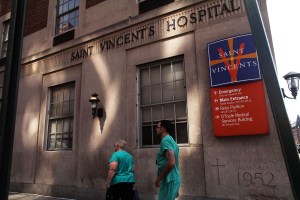
St. Vincent’s vanished in pieces—the ambulance service went first, and the maternity ward, oddly enough, was among the last, departing with a rousing 6-pound, 15-ounce yowl. “The Wall of Hope and Remembrance,” as it’s come to be called, disappeared years earlier, but the pasted words remain, slightly cryptic in all their weighty grandiosity, testifying to their mute slab of hospital brick.
For years, the wall on West 11th Street was a shrine of photographs, hasty fliers, scribbled pleas—all amassed in the days following September 11, when the city’s center of gravity shifted southward, and St. Vincent’s, the only emergency room below 59th Street, became a point of convergence. It wasn’t the city’s only impromptu memorial, but it was the one that stuck, glued to the hospital wall for years, a curiously paused still frame in the city’s onward rush.
In any city—but particularly a city as averse to dying as New York—a hospital is a kind of vanishing point, the closest thing to a reprieve from the implacable mantra onward. (Manhattan outlawed cemeteries, if not mortality itself, in 1852, and started shipping its dead to the outer boroughs.) Nineteenth-century hospitals like St. Vincent’s emerged as stopgap antidotes to a new industrial landscape, one that churned its largely immigrant labor force through brutal working conditions and left them, as labor leader Ira Seward put it, “within a few days of want, if through sickness, or other misfortune, employment suddenly stops.” St. Vincent’s offered sustenance and a bed, a respite of temporary stillness, a glorified poorhouse putting on medical airs.
If, in its haste to master the modern science of bed turnover, St. Vincent’s lost that sense of sanctuary, it at least served as a partial remedy to the city’s chronic amnesia. Among the memorials New York has never built is a memorial commemorating its more than 85,000 AIDS deaths. At a time when efforts to ban discrimination based on sexual orientation were being roundly condemned by the Roman Catholic Archdiocese of New York, the hospital rooms under its tutelage overflowed with gay men, as St. Vincent’s emerged as the unlikely ground zero in the AIDS epidemic. In the 1980s, roughly a third of its AIDS patients died each year, and for that, St. Vincent’s was a kind of mute testimony.
WHEN A STORM unhinged its plexiglass encasement several winters ago, the contents of the Wall of Hope and Remembrance were gathered into binders, four of them, and entombed alphabetically in the annals of hospital storage. The Sisters of Charity who served as its guardians intended to restore the wall eventually, but in 2005, St. Vincent’s underwent the costliest hospital bankruptcy in the history of New York. Historic preservation plummeted on the triage list.
In fact, the hospital’s final years were marked by a series of protracted battles with Greenwich Village residents, who argued that the institution’s development plans would mar the neighborhood’s historic texture. Following bankruptcy and several shifts in administration, St. Vincent’s hired a slew of pricey consultants–seasoned veterans of the hospital-industrial complex—and recruited celebrities to the cause (among them Eli Manning for roughly $600,000). The board of directors, in conjunction with real estate developer Rudin Management Company, laid out plans to reconfigure the hospital’s unwieldy layout, dispersed across several blocks, into a single, streamlined facility.
To clear the way for new construction, the proposal called for the hospital’s most famous structure, the bucktoothed former headquarters of the National Maritime Union, to be demolished. (That when St. Vincent’s purchased the porthole-bedecked fortress in 1973 the building was barely a decade old and already symbolized things long gone–a New York City with port jobs and a resilient organized labor movement, for instance—maybe should have been taken as a portent of things to come.)
And—because what in Manhattan would ever get built without it?—the cylindric new edifice would be accompanied by a luxury residential condo, the spoonful of high-rise incentive for Rudin. The opportunity to insert a shiny glass chunk of real estate into one of the city’s most lucrative housing markets (and a landmarked historic district, no less) could make even an unpalatable nonprofit hospital project go down.
Unfortunately for Rudin and for the hospital, Village preservationists had their own team of celebrity crusaders. Eli Manning proved no match for the likes of residents Susan Sarandon and Tim Robbins, who sung the praises of the neighborhood’s special properties as an artists’ colony (though real estate prices had long ago pushed out the artists) and the stunted Village skyline (no longer quite so stunted).


